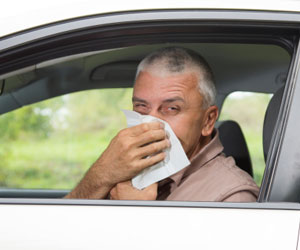The Common Cold May Be a Traffic Hazard
 Fatigue is quickly becoming recognized as one of the most dangerous driving impairments. But that drowsiness is not just the product of sleep deprivation or over-exertion. Sluggishness resulting from the common cold can also hamper driving abilities.
Fatigue is quickly becoming recognized as one of the most dangerous driving impairments. But that drowsiness is not just the product of sleep deprivation or over-exertion. Sluggishness resulting from the common cold can also hamper driving abilities.
Psychologists Andrew Paul Smith and Samantha Jamson of Cardiff University wanted to investigate if individuals with a cold performed poorly on simulated driving tasks.
The researchers conducted a two part, divided-attention test on 25 English college students. These volunteers were split into either a “Healthy” or “Colds” sample based on the self-assessed severity of their cold symptoms.
The first test measured how often participants would miscalculate collisions of geometric shapes coming from random directions and speeds on a screen. The students were also instructed to press a foot pedal if those geometric shapes matched those on the border of the screen.
The second test used a driving simulation that measured how frequently the volunteers incorrectly timed a turn, causing them to collide with a series of common obstacles, such as pedestrians and making turns through oncoming traffic. Speeding and traffic light violations were also calculated.
Smith and Jamson found that those students with a cold performed more poorly than their healthier counterparts in many of the measurements.
Particularly, participants with a cold were significantly more likely to react slower to target stimuli, collide into pedestrians, and keep unsafe distances when following other cars.
The results, published in BMJ Open Journal, suggest that driving with the sniffles may be hazardous to your safety, and the safety of others.
Smith, A.P., Jamson, S., (2014). An investigation of the effects of the common cold on simulated driving performance and detection of collisions: a laboratory study. BMJ Open, doi:10.1136/bmjopen-2012-001047





APS regularly opens certain online articles for discussion on our website. Effective February 2021, you must be a logged-in APS member to post comments. By posting a comment, you agree to our Community Guidelines and the display of your profile information, including your name and affiliation. Any opinions, findings, conclusions, or recommendations present in article comments are those of the writers and do not necessarily reflect the views of APS or the article’s author. For more information, please see our Community Guidelines.
Please login with your APS account to comment.